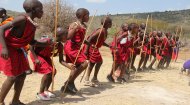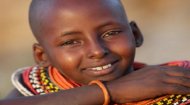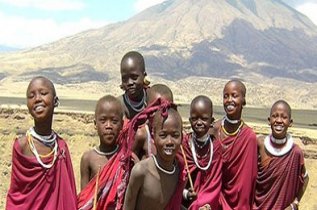|
|
At the age of seven, Maasai boys traditionally have the top of their right earlobe pierced signalling the taking on of more responsibilities such as looking after older calves and herding cattle with the rest of the family. The next stage for Maasai children is at the age of sixteen or seventeen when the lower lobes of both ears are pierced in a ceremony that augurs a new period when they take on sole responsibility for cattle and moving herds. The education of Maasai children is a fascinating interplay between the time-honoured lessons of their ancestors and the increasing influence of formal schooling. For generations, traditional education was paramount, passed down orally through stories, proverbs, songs, and practical demonstrations. Elders serve as living libraries, imparting knowledge of history, legends, moral codes, and survival skills. Children learn the value of respect, generosity, bravery, and the deep interconnectedness of their community and environment. This traditional curriculum is immersive and continuous, interwoven into every aspect of daily life. However, the advent of modern formal education presents both opportunities and challenges. Historically, school attendance among Maasai children was low, primarily due to their semi-nomadic lifestyle, the long distances to schools, the lack of culturally relevant curricula, and a perceived conflict with traditional values. Children enrolled in school often had to board, separating them from their families and the daily learning of their cultural heritage. Language barriers (Maa versus Swahili or English) also posed significant hurdles. While some Maasai children do undertake secondary education, few have the opportunity to attend college. While at school, they learn English and Swahili, however their native language, Maa, is still spoken at home. Obviously when they are at school they cannot perform their expected, traditional duties so such attendance is rarely encouraged and the situation is even worse for girls as there is a clear expectation that, on growing up, they will marry and live with their husband's kin without need for any skills outside domestic duties and child-rearing. (Culturally, Maasai girls normally are offered by fathers to marry older men to marry, often when they are between the ages of twelve and fourteen.) In recent decades, there has been a growing recognition of the importance of formal education, driven by government initiatives, NGO support, and changing aspirations within the Maasai community. The challenge remains in how to integrate this formal education with the preservation of their unique cultural identity, ensuring that children can gain literacy and numeracy without losing their profound connection to their roots. This often means children juggle school attendance with their traditional responsibilities, waking early to tend to chores before embarking on long walks to school. Despite their significant responsibilities, daily life for Maasai children includes ample time for play, which is often an extension of their learning. Games frequently imitate adult activities: boys might "herd" stones or sticks as cattle, constructing miniature bomas, while girls engage in mock cooking or childcare with dolls made from cloth or corn husks. Foot races, jumping contests (a precursor to the adumu or jumping dance), and singing games are popular. Storytelling around the evening fire, often led by elders, is a cherished communal activity that combines entertainment with important moral and historical lessons. Socialisation within the Maasai community is incredibly strong. Children grow up in large family units, surrounded by siblings, cousins, and age-mates. This fosters deep bonds and a collective identity, where the welfare of the group often takes precedence over individual desires. From a young age, they learn the importance of sharing, cooperation, and mutual support, qualities vital for survival in their challenging environment. This communal upbringing instils a strong sense of belonging and cultural pride. |
Maasai Children |
Maasai Children |
Maasai Children | Maasai Children |
Now explore all about the east African country of Kenya in a series of articles, videos and images.
More >
 |

Maasai Children The traditional Maasai diet largely consists of milk, blood, and meat from their livestock, providing essential nutrients. Children are adapted to this diet from an early age. However, access to modern healthcare can be challenging due to remote living and limited facilities. Common childhood illnesses, sometimes exacerbated by environmental factors like water scarcity, are often initially treated with traditional herbal remedies passed down through generations. Nevertheless, there's a growing reliance on formal clinics and medical outreach services, reflecting a pragmatic approach to health and well-being. Maasai children exhibit remarkable resilience. They are accustomed to walking long distances, enduring harsh weather conditions, and adapting to resource scarcity, particularly during droughts. This resilience is not just physical; it's a deep-seated mental fortitude, cultivated by a life that demands pragmatism, endurance, and a strong collective spirit. For Maasai children, the journey from childhood to adulthood is punctuated by significant rites of passage, ceremonies that mark their transition into new stages of life and responsibility. The most prominent of these, especially for boys, is Emuratare, or male circumcision. This intensely significant ceremony, typically taking place in early adolescence, is a test of courage and endurance. Boys undergo the procedure without showing pain, a demonstration of the stoicism and bravery expected of a Maasai man. Following this, they enter a period of healing and seclusion, emerging as morans (junior warriors), taking on new responsibilities for community protection and livestock management. This transition is celebrated with elaborate feasts, songs, and dances, solidifying their new status and identity. Maasai boys can then decorate themselves with olive branches and can carry a quiver. While girls also undergo initiation ceremonies traditionally marking their transition to womanhood and readiness for marriage, the most controversial practice, Female Genital Mutilation (FGM), has seen a significant decline due to strong advocacy and community efforts, though challenges remain in some isolated areas. Around this time Maasai girls are dressed in black robes and a leather decoration is put in her pierced ear lobe. Modern Maasai communities, increasingly aware of the health risks and human rights implications, are adopting alternative rites of passage that celebrate a girl’s maturity without harmful practices. Daily life for Maasai children today is increasingly complex. They are growing up in a world where their traditional way of life faces unprecedented pressures. Climate change brings more frequent and severe droughts, threatening their cattle and traditional livelihoods. Land encroachment for agriculture, conservation, or development further restricts grazing areas. The allure of urban centres and modern careers can draw younger generations away from their pastoral roots. However, the Maasai are renowned for their adaptability. Communities are finding ways to blend tradition with modernity. This includes embracing education, diversifying economic activities beyond solely livestock, and using technology (like mobile phones) to connect with markets or access information. Maasai children are at the forefront of this evolution, learning from both their elders and the wider world, poised to become a bridge between their rich past and a dynamic future. The life for Maasai children is a testament to the enduring power of culture, community, and connection to the land. It is a childhood of responsibility, practical learning, and deep cultural immersion, fostering qualities of resilience, respect, and communal identity that are increasingly rare in a globalised world. As they grow, these children carry the weight and pride of their heritage, poised to navigate the challenges of the 21st century while safeguarding the unique spirit of the Maasai people. Their future, like the vast plains they call home, is a blend of continuity and change, a vibrant canvas where ancient traditions meet the horizon of new possibilities. |
 Girls, on the other hand, are initiated into the domestic sphere. From a remarkably young age, they begin assisting their mothers and older sisters with household chores. Fetching water from distant boreholes or rivers, gathering firewood, sweeping the enkaji, and caring for younger siblings become their primary responsibilities. They learn the art of preparing traditional meals, milking cows, and maintaining the homestead. Intricate beadwork, a significant form of Maasai artistic expression and identity, is also taught early, with girls learning to create beautiful collars, bracelets, and other adornments. This rigorous domestic training ensures they are well-prepared for their future roles as wives and mothers, central to the stability and comfort of the family.
Girls, on the other hand, are initiated into the domestic sphere. From a remarkably young age, they begin assisting their mothers and older sisters with household chores. Fetching water from distant boreholes or rivers, gathering firewood, sweeping the enkaji, and caring for younger siblings become their primary responsibilities. They learn the art of preparing traditional meals, milking cows, and maintaining the homestead. Intricate beadwork, a significant form of Maasai artistic expression and identity, is also taught early, with girls learning to create beautiful collars, bracelets, and other adornments. This rigorous domestic training ensures they are well-prepared for their future roles as wives and mothers, central to the stability and comfort of the family.







